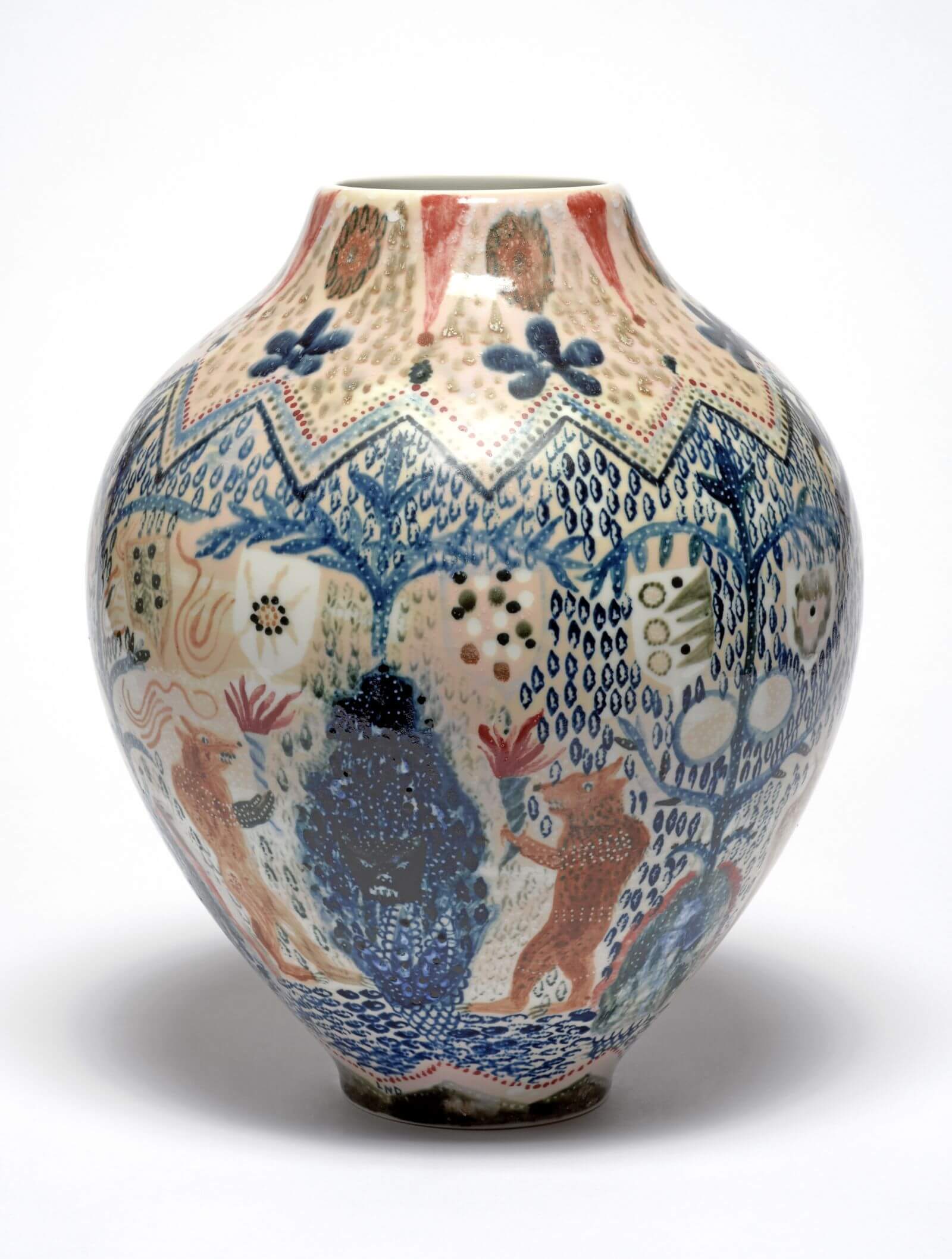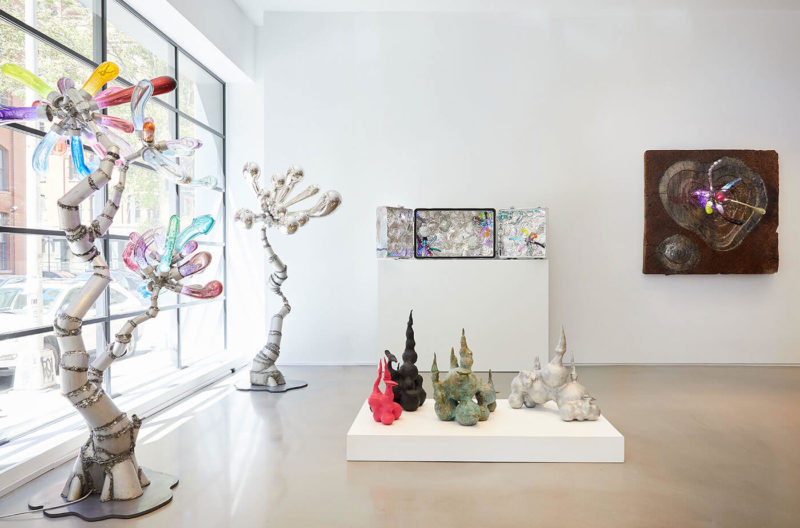Paris Dispatch / July 2022
We round up the hottest summer shows in the coolest galleries in heatwave Paris.
Galerie Maria Wettergren: ‘Rasmus Fenhann – Light’
Until 26th July 2022
Galerie de Sèvres: ‘Ulla von Brandenburg, Hélène Delprat and Annette Messager’
Until 22nd July 2022
Galerie Italienne: ‘Ceramics Now’
Until 23rd July 2022
Triode: ‘Anna Karlin, Bec Brittain and Rosie Li’
Until early August 2022

Exhibition view, ‘Ceramics Now’, Galerie Italienne, 2022
COURTESY: Galerie Italienne
AS PARIS IS subjected to another blazing heatwave, air-conditioned galleries provide a cool haven from the sweltering temperatures. On offer this month is a panoply of craftsmanship and ceramics, demonstrating how designers continue to reinvent the wheel.
Galerie Maria Wettergren: ‘Rasmus Fenhann – Light’
“I really like to make simple pieces that are harmonious, beautiful and strong,” says Danish designer Rasmus Fenhann, of his solo show of lighting, furniture and objects. The sense of harmony arises from the meticulous geometries integral to each piece.

Rasmus Fenhann, ‘Kumiko Shelf Low’, 2021
COURTESY: Rasmus Fenhann & Galerie Maria Wettergren / PHOTOGRAPH: Rasmus Fenhann
The oldest work on display is the exquisite ebony and wood ‘Secret Box’ (2000) which Fenhann made while still a student at the Danish Design School. Inspired by jewellery boxes and the tradition of Danish cabinetmaking, it contains several secret matchbox-sized drawers.

Rasmus Fenhann, ‘Secret Box’, 2000
COURTESY: Rasmus Fenhann & Galerie Maria Wettergren / PHOTOGRAPH: Jeppe Gudmundsen- Holmgreen
It was while he was at the Danish Design School that Fenhann decided to spend a semester in Japan apprenticing with master craftsmen in cabinetmaking studios. He went back to Japan two years later, his experiences influencing work such as the ‘Kumiko’ shelves (2019) and ‘Hikari’ pendant lamps made with shoji paper, their elm wood structures realised in geometric proportions derived from the golden ratio mathematical formula.

Exhibition view, ‘Rasmus Fenhann – Light’, 2022, Galerie Maria Wettergren
COURTESY: Rasmus Fenhann & Galerie Maria Wettergren / PHOTOGRAPH: Margot Montigny
Exploration of mathematical forms, particularly those found in nature, lies at the heart of Fenhann’s work. The sinuous curves in the white maple ‘Sakyu’ table (2020), named after the Japanese word for sand dune, are evocative of the lines of sand in a desert while the hexagonal pattern on the tactile surface of the oak ‘Hyomen’ bench (2017) is reminiscent of honeycomb. “Looking at these shapes can help you calm down as a human being because the structures add up [mathematically],” Fenhann reasons.

Rasmus Fenhann, ‘Sakyu Bench/Table’, 2018
COURTESY: Rasmus Fenhann & Galerie Maria Wettergren / PHOTOGRAPH: Anders Sune Berg
Galerie de Sèvres: ‘Ulla von Brandenburg, Hélène Delprat and Annette Messager’
The Manufacture de Sèvres dates back to 1740, when a porcelain atelier was founded in the royal château of Vincennes during the reign of Louis XV, under the auspices of Madame de Pompadour. Porcelain manufacturing and a museum dedicated to its masterpieces was set up in 1876 in the building in Sèvres, southwest of Paris, that it still occupies today. One of the original 19th century wood-fired kilns remains in use and, thanks to its enormous size, still enables monumental pieces to be fired.

Ulla von Brandenburg, ‘Paar (Couple)’, 2021
COURTESY: Ulla von Brandenburg & Galerie de Sèvres / PHOTOGRAPH: Gérard Jonca
Last year, three female artists of different generations – Ulla von Brandenburg, Hélène Delprat and Annette Messager – were invited to produce works at Sèvres, using the kiln which is only used once every five years. Firing lasted 33 hours and it was only after the kiln had completely cooled down a month later that their vessels could be taken out.

Hélène Delprat, Vase
COURTESY: Hélène Delprat & Galerie de Sèvres / PHOTOGRAPH: Gérard Jonca
None of the artists specialises in porcelain, but they all rose to the challenge. Brandenburg, a German artist known for performances and installations, has depicted dancers and theatrical characters. Delprat has conjured a mystical forest inhabited by bats, skeletons and crows. Messager, meanwhile, has made poetic pieces reflecting on femininity, love and death, such as a vessel featuring a pair of breasts and a blue heart formed by two skulls. These unique pieces are on view in a gallery owned by the Manufacture de Sèvres near the Tuileries gardens.

Annette Messager, ‘Untitled’, 2021
COURTESY: Annette Messager & Galerie de Sèvres / PHOTOGRAPH: Gérard Jonca
Galerie Italienne: ‘Ceramics Now’

Exhibition view, ‘Ceramics Now’, Galerie Italienne, 2022
COURTESY: Galerie Italienne
The second group ceramics show from this gallery brings a vibrant medley of diverse styles. One of the themes is the animal world and imaginary creatures. A series of idiosyncratic, naive animal-inspired sculptures – such as a blue-and-yellow sculpture with a cat’s outsized mouth and a column-shaped body with six fins – is by Timothée Humbert. Meanwhile, intricate, fairytale-like creatures in the form of totems or a dragon are by Saraï Delfendahl, on loan from Galerie Scène Ouverte. By contrast, it is the underwater world that has served as inspiration for the delicate, tangled works reminiscent of coral by Claire Lindner.

Exhibition view, ‘Ceramics Now’, Galerie Italienne, 2022
COURTESY: Galerie Italienne
Other standouts include French-Beninese artist King Houndekpinkou’s exuberantly glazed works in eye-popping colours with both smooth and spiky forms, cracked surfaces and gold encrustations alongside Romuald Jandolo’s hybridised pieces drawing on masks and animals, such as beaded sculptures with excavated eyes and vases with animal faces.
Triode: ‘Anna Karlin, Bec Brittain and Rosie Li’
Space-defining creations by three female designers – Anna Karlin, Bec Brittain and Rosie Li – light up this gallery in the Saint-Germain-des-Prés district. Triode was founded by Jacques Barret, who started out as a design dealer specialising in works from the 1930s-1950s in the Saint Ouen flea market. Barret opened his Left Bank showroom in 2004 with the aim of championing American designers and introducing them to a European clientele.
Pride of place has been given to Rosie Li’s ‘Fluted Ginkgo Blossom Totem Chandelier’ (2022), featuring antique brass leaves and faceted glass buds in the spirit of Art Nouveau. Based on China’s ginkgo plant, this on-trend piece is the latest iteration of custom-made blossom lights developed by Li and engineer Philip Watkins in their New York studio.

Rosie Li, ‘Fluted Ginkgo Blossom Totem Chandelier’, 2022
COURTESY: Rosie Li & Triode / PHOTOGRAPH: Black & Steil
Also striking is Karlin’s aptly titled ‘Face Light’ (2022) – a brass, floor-to-ceiling line sculpture evoking the profile of a face with a lightbulb inside an almond-shaped eye. Another piece by Karlin – a British designer who opened a studio in New York after graduating from Glasgow School of Art – is ‘Sculpture Form Light’, which is intersected with blown glass, marble and bronze elements.

Exhibition view, ‘Anna Karlin, Bec Brittain and Rosie Li’, 2022, Triode
COURTESY: Troide / PHOTOGRAPH: Alexis Toureau
Meanwhile, Brittain has embraced abstract, intuitive shapes to create ‘Helix Short Ellipse Counterweight Suspension’ – a brass pendant light with a marble disc, reminiscent of contemporary jewellery – as well as sconces with diamond-shaped pink glass. With such interesting pieces, it is just a shame that there isn’t a stronger curated theme behind the exhibition, to draw out their qualities.

Exhibition view, ‘Anna Karlin, Bec Brittain and Rosie Li’, 2022, Triode
COURTESY: Troide / PHOTOGRAPH: Alexis Toureau







